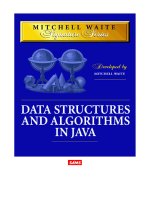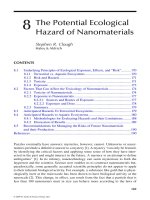Data Structure and Algorithms CO2003 Chapter 8 Heap
Bạn đang xem bản rút gọn của tài liệu. Xem và tải ngay bản đầy đủ của tài liệu tại đây (939.99 KB, 44 trang )
Data Structure and Algorithms [CO2003]
Chapter 8 - Heap
Lecturer: Duc Dung Nguyen, PhD.
Contact:
October 17, 2016
Faculty of Computer Science and Engineering
Hochiminh city University of Technology
Contents
1. Heap Definition
2. Heap Structure
3. Basic Heap Algorithms
4. Heap Data Structure
5. Heap Algorithms
6. Heap Applications
1
Outcomes
• L.O.4.1 - List some applications of Heap.
• L.O.4.2 - Depict heap structure and relate it to array.
• L.O.4.3 - List necessary methods supplied for heap structure, and describe them using
pseudocode.
• L.O.4.4 - Depict the working steps of methods that maintain the characteristics of heap
structure for the cases of adding/removing elements to/from heap.
2
Outcomes
• L.O.4.5 - Implement heap using C/C++.
• L.O.4.6 - Analyze the complexity and develop experiment (program) to evaluate methods
supplied for heap structures.
• L.O.8.4 - Develop recursive implementations for methods supplied for the following
structures: list, tree, heap, searching, and graphs.
• L.O.1.2 - Analyze algorithms and use Big-O notation to characterize the computational
complexity of algorithms composed by using the following control structures: sequence,
branching, and iteration (not recursion).
3
Heap Definition
Heap Definition
Definition
A heap (max-heap) is a binary tree structure with the following properties:
1. The tree is complete or nearly complete.
2. The key value of each node is greater than or equal to the key value in each of its
descendents.
(Source: Data Structures - A Pseudocode Approach with C++)
4
Heap Definition
Definition
A min-heap is a binary tree structure with the following properties:
1. The tree is complete or nearly complete.
2. The key value of each node is less than or equal to the key value in each of its descendents.
(Source: Data Structures - A Pseudocode Approach with C++)
5
Heap Structure
Heap trees
6
Invalid Heaps
(Source: Data Structures - A Pseudocode Approach with C++)
7
Basic Heap Algorithms
ReheapUp
The reheapUp operation repairs a "broken" heap by floating the last element up the tree until
it is in its correct location in the heap.
8
ReheapDown
The reheapDown operation repairs a "broken" heap by pushing the root down the tree until it
is in its correct location in the heap.
9
Heap Data Structure
Properties of Heaps
• A complete or nearly complete binary tree.
• If the height is h, the number of nodes N is between 2h−1 and 2h − 1.
• Complete tree: N = 2h − 1 when last level is full.
• Nearly complete: All nodes in the last level are on the left.
→ Heap can be represented in an array.
10
Heap in arrays
(Source: Data Structures - A Pseudocode Approach with C++)
11
Heap Data Structure
The relationship between a node and its children is fixed and can be calculated:
1. For a node located at index i, its children are found at
• Left child: 2i + 1
• Right child: 2i + 2
2. The parent of a node located at index i is located at (i − 1)/2 .
3. Given the index for a left child, j, its right sibling, if any, is found at j + 1. Conversely,
given the index for a right child, k, its left sibling, which must exist, is found at k − 1.
4. Given the size, N , of a complete heap, the location of the first leaf is N/2 .
5. Given the location of the first leaf element, the location of the last nonleaf element is 1
less.
12
Heap Algorithms
ReheapUp Algorithm
Algorithm reheapUp(ref heap <array>, val position <integer>)
Reestablishes heap by moving data in position up to its correct location.
Pre: All data in the heap above this position satisfy key value order of a heap, except the
data in position
Post: Data in position has been moved up to its correct location.
13
ReheapUp Algorithm
if position > 0 then
parent = (position-1)/2
if heap[position].key > heap[parent].key then
swap(position, parent)
reheapUp(heap, parent)
end
end
return
End reheapUp
14
ReheapDown Algorithm
Algorithm reheapDown(ref heap <array>, val position <integer>, val lastPosition <integer>)
Reestablishes heap by moving data in position down to its correct location.
Pre: All data in the subtree of position satisfy key value order of a heap, except the data in
position
lastPosition is an index to the last element in heap
Post: Data in position has been moved down to its correct location.
15
ReheapDown Algorithm
leftChild = position * 2 + 1
rightChild = position * 2 + 2
if leftChild <= lastPosition then
if (rightChild <= lastPosition) AND (heap[rightChild].key > heap[leftChild].key then
largeChild = rightChild
else
largeChild = leftChild
end
if heap[largeChild].key > heap[position].key then
swap(largeChild, position)
reheapDown(heap, largeChild, lastPosition)
end
end
return
End reheapDown
16
Build a Heap
• Given a filled array of elements in random order, to build the heap we need to rearrange
the data so that each node in the heap is greater than its children.
• We begin by dividing the array into two parts, the left being a heap and the right being
data to be inserted into the heap. Note the "wall" between the first and second parts.
• At the beginning the root (the first node) is the only node in the heap and the rest of the
array are data to be inserted.
• Each iteration of the insertion algorithm uses reheap up to insert the next element into the
heap and moves the wall separating the elements one position to the right.
17
Build a Heap
18
(Source: Data Structures - A Pseudocode Approach with C++)
Build a Heap
Algorithm buildHeap(ref heap <array>, val size <integer>)
Given an array, rearrange data so that they form a heap.
Pre: heap is array containing data in nonheap order
size is number of elements in array
Post: array is now a heap.
walker = 1
while walker < size do
reheapUp(heap, walker)
walker = walker + 1
end
End buildHeap
19









